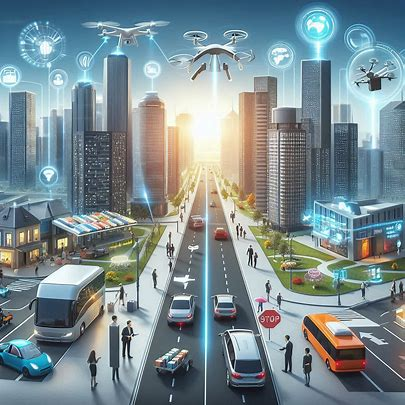Future Of The Internet of Things (IoT)
- Get link
- X
- Other Apps
Introduction
The Internet of Things (IoT) is a rapidly evolving technology transforming how we live, work, and interact with the world around us. IoT refers to the network of interconnected devices that communicate and share data with each other, creating a seamless and intelligent environment. From smart homes and cities to industrial automation and healthcare, IoT has the potential to revolutionize various aspects of our lives. In this blog, we will explore the future of IoT, its potential applications, challenges, and the impact it may have on society.
Current State of IoT
Before delving into the future, it's important to understand the current state of IoT. Today, IoT encompasses a wide range of devices, including smart home appliances, wearable technology, industrial sensors, and connected vehicles. These devices collect and transmit data, enabling real-time monitoring, control, and automation. According to recent estimates, there are already billions of IoT devices in use worldwide, and this number is expected to grow exponentially in the coming years.
Potential Applications of IoT in the Future
1. Smart Homes
One of the most visible applications of IoT is in the realm of smart homes. In the future, smart homes will become even more intelligent and intuitive. Imagine a home where your refrigerator can order groceries when you're running low, your thermostat adjusts itself based on your preferences and daily routine, and your security system can detect and respond to threats in real-time. IoT will enable seamless integration and control of various household devices, making our lives more convenient and efficient.
2. Smart Cities
The concept of smart cities is gaining traction as urban areas seek to improve the quality of life for their residents. IoT will play a crucial role in creating connected and sustainable cities. Smart traffic management systems will reduce congestion and improve transportation efficiency, while smart grids will optimize energy consumption. Additionally, IoT-enabled sensors can monitor air quality, water usage, and waste management, helping cities become more environmentally friendly and resilient.
3. Healthcare
IoT has the potential to revolutionize healthcare by enabling remote monitoring, personalized treatment, and improved patient outcomes. Wearable devices and smart medical equipment can continuously monitor vital signs and alert healthcare providers in case of abnormalities. In the future, IoT could facilitate telemedicine, allowing patients to receive medical care from the comfort of their homes. This will be particularly beneficial for individuals with chronic conditions or those living in remote areas.
4. Industrial Automation
The industrial sector is already benefiting from IoT through increased automation, predictive maintenance, and improved supply chain management. In the future, IoT will enable even greater levels of efficiency and productivity. For example, factories equipped with IoT sensors can monitor machinery in real-time, predicting failures before they occur and minimizing downtime. IoT can also enhance worker safety by providing real-time data on hazardous conditions and enabling remote control of dangerous processes.
5. Agriculture
IoT has the potential to revolutionize agriculture by enabling precision farming and optimizing resource usage. IoT-enabled sensors can monitor soil moisture, temperature, and crop health, allowing farmers to make data-driven decisions. Automated irrigation systems can ensure optimal water usage, reducing waste and improving crop yields. In the future, IoT could help address global food security challenges by increasing agricultural productivity and sustainability.
Challenges and Considerations
While the future of IoT holds immense promise, several challenges and considerations need to be addressed for its widespread adoption and success.
1. Security and Privacy
The proliferation of IoT devices raises significant security and privacy concerns. As more devices become connected, the potential attack surface for cybercriminals expands. Ensuring the security of IoT networks and protecting user data will be paramount. Robust encryption, authentication mechanisms, and regular software updates will be essential to mitigate security risks.
2. Interoperability
The IoT ecosystem consists of devices from various manufacturers, each with its own protocols and standards. Ensuring interoperability and seamless communication between these devices will be crucial for realizing the full potential of IoT. Industry-wide standards and frameworks need to be established to facilitate compatibility and integration.
3. Scalability
As the number of IoT devices continues to grow, scalability will become a critical consideration. IoT networks must be capable of handling massive amounts of data and accommodating a large number of devices without compromising performance. Cloud computing and edge computing will play a vital role in addressing scalability challenges.
4. Ethical and Legal Issues
The widespread adoption of IoT raises ethical and legal questions regarding data ownership, consent, and usage. Clear regulations and policies need to be established to protect individuals' rights and ensure responsible use of IoT technologies. Additionally, ethical considerations related to algorithmic bias and automated decision-making must be carefully addressed.
Conclusion
The future of the Internet of Things is incredibly promising, with the potential to transform various aspects of our lives. From smart homes and cities to healthcare, industrial automation, and agriculture, IoT will enable new levels of convenience, efficiency, and sustainability. However, realizing this potential will require addressing challenges related to security, interoperability, scalability, and ethical considerations. As technology continues to evolve, the future of IoT holds the promise of a more connected and intelligent world, enhancing our lives in ways we can only imagine today.
- Get link
- X
- Other Apps


Comments
Post a Comment